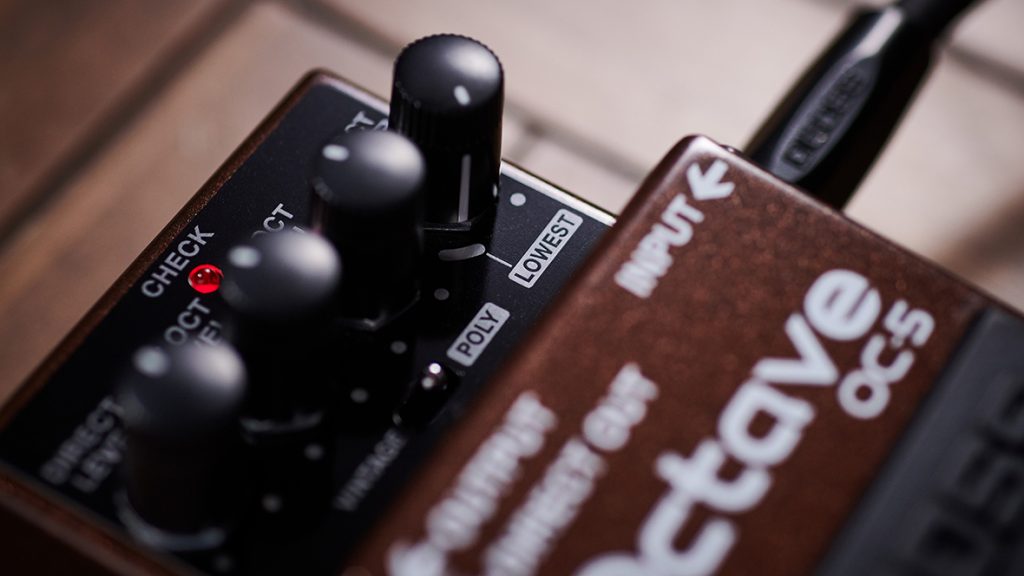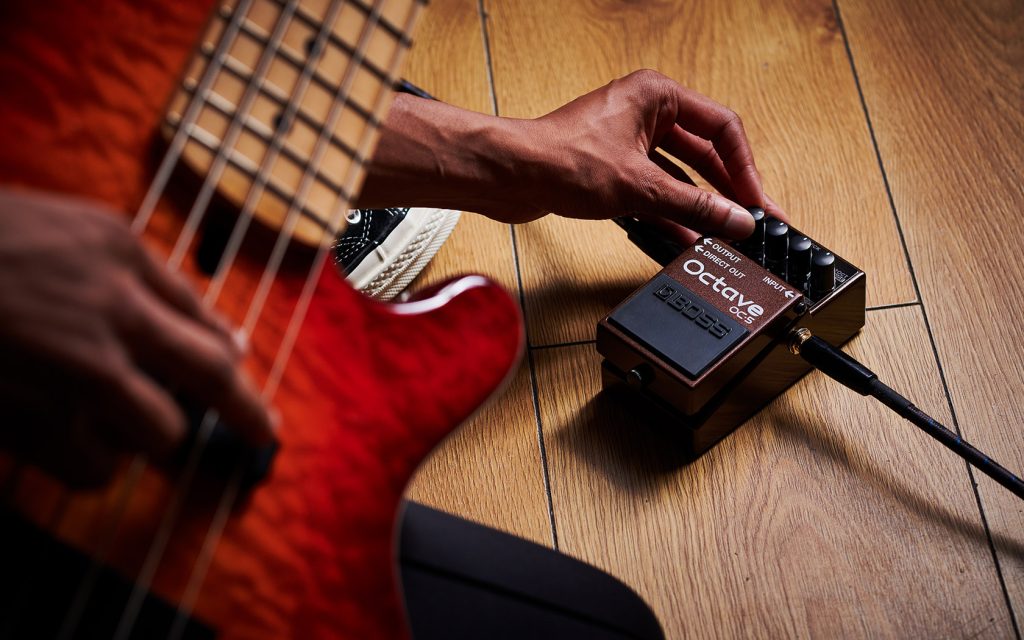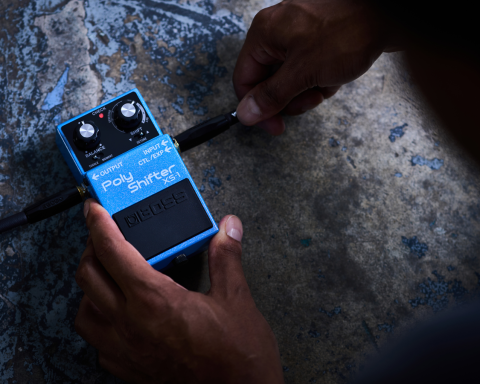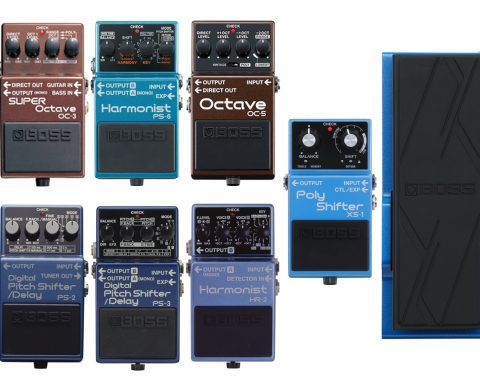The octave pedal can be one of the most creative tools in your sonic arsenal. Turn a guitar into a baritone, a bass, or a synthesizer. Use it subtly to fatten riffs or aggressively to create entirely new sounds. Octave is an effect loved in equal measure by guitarists, bassists, and keyboard players. BOSS introduced the first compact analog octave pedal, the OC-2, back in 1982. Explore the myriad possibilities of this remarkable effect.
The Legacy of the BOSS Octave
The OC-2 represented a new type of sound-expanding effect for guitarists and bassists. Quickly, the pedal became a well-loved and commonly used pedal throughout its time in production. The unit got superseded in 2003 by the OC-3, the first octave pedal to introduce polyphony. This is the ability to pitch octaves to many notes simultaneously, rather than monophonic octaving common to analog units. The OC-5 in 2021 continues the legacy.
The OC-2 has become such a legendary pedal that BOSS includes a vintage mode on the OC-5 to emulate the original tone of the analog classic. In simple terms, an octave pedal adds an octave beneath or above a played note. Depending on the desired effect, this doubling note can remain balanced in volume with a clean signal to support or overpower it.
"An octave pedal adds an octave beneath or above a played note. This doubling note can remain balanced in volume with a clean signal to support or overpower it."
How Octave Pedals Work
Only monophony was possible on the original analog octave pedals so that the octave pedal could pitch only one note at any time. This limitation made it ideal for simple riffs or basslines but unsuitable for chords. Pitching accurately also became difficult in the lower registers. There is a sweet spot for analog octave pedals, and using one accurately was a skill that required careful playing. The guitar solo on Led Zeppelin’s “Fool In The Rain” is a great example.
With the introduction of digital octaving and polyphony, those restrictions got lifted. Players could now access otherwise difficult note ranges and use octave pedals for chords. This feature opened up synth and organ-like tonal capabilities. Bands like The Mars Volta use this to great effect on tracks like “Son et Lumiere” and “Cicatriz Esp.”
Setup Considerations
When introducing an octave pedal into a setup, it’s essential to keep it as close to the start of the pedal chain as possible. The signal received by the pedal needs to be as clear as possible to pitch accurately. Placing a modulation effect in front of an octave pedal can cause the monophonic device to glitch between the played and modulated note.
FIVE OCTAVE PEDAL USES
1. Synthesizer Tones
While the functionality of each BOSS octave pedal differs, they all share a few key features. These are volume or mix controls for clean signal, an -1 octave, and a -2 octave. A simple and exciting way to completely reinvent a sound is to roll off all the clean signal, removing any natural guitar tone from the mix. Then blend in the -1 and -2 octaves to full clockwise rotation.
The analog reproduction of the notes played will lack the strings’ organic attack and natural modulation. This results in a much less dynamic sound, more reminiscent of a synthesizer than an electric guitar. Blending a -1 and -2 octave can be very powerful and full-bodied. This setting can create wild bass synth tones with a high-gain amplifier.
"Polyphonic octaves on the OC-5 open new creative ways to utilize the pedal."
2. Organ Tones
Polyphonic octaves on the OC-5 open new creative ways to utilize the pedal. Pitching multiple notes in several octaves at once can create vast walls of sound. This feature allows a player to do a lot with a single instrument.
Using the polyphonic setting on the octave pedal, introduce the +1 and -1 octaves in equal measures at a relatively high setting. Then dial in the -2 octave, and the clean signal slightly lower. Used for chords, and with a clean amp, ideally with some reverb, it can create organ-like sounds. The effect is perfect for experimentation. Plus, there is no need to haul a Hammond to gigs.

3. Wet/Dry Mixes
One of the most valuable features of the OC-5 is the addition of a Direct Output next to the output on the pedal. This allows dry and affected signals to get sent to different amplifiers or onto other effects for individual processing.
Two-piece bands with solo guitarists often use this feature to compensate for the lack of a bass player. The standard output of the octave pedal sends the dry signal to the rest of the effects chain and, finally, the amplifier. At the same time, the Direct Out sends a -1 clean octave signal onto a bass amplifier, DI, or Front of House. The separation within the pedal means the bass signal remains distinct and clean. At the same time, the guitar can add less bass-friendly effects, like delay and reverb.
"Separation within the pedal means the bass signal remains distinct and clean. At the same time, the guitar can add less bass-friendly effects, like delay and reverb."
4. Advanced Bass Accompaniment
Let’s expand on using an octave pedal to deal with bass duties when playing guitar. One doesn’t necessarily need a dual amplifier setup to make the most of this clever effect. The Range control on the OC-5 allows players to dial in precisely what frequencies the pedal affects. This can be useful for bass accompaniment to chords or a picked arrangement. Set to the lowest setting, the range control will apply the octave effect to only the lowest note in a chord. Solo acoustic guitarist Mike Dawes uses this feature to fill out the tonal spectrum in his music.

5. Riff Fattening
The octave pedal doesn’t always have to be so overt. Turning a guitar into a bass or an organ is a particular application. However, the most common octave pedal use is fattening up riffs. Bass players have been strong advocates of the octave pedal throughout the decades. Still, they don’t use the pedal as aggressively as we’ve discussed here.
An octave pedal can offer subtle support and tonal enhancement for both bass and guitar. One can create a present, supportive octave effect by setting the clean blend fully clockwise. Then dial the -1 octave to under halfway and set the -2 to around nine o’clock. The clean signal will still dominate. Thus, the clarity of the guitar or bass remains the focal point. At the same time, octaves support and fatten each note. Perfect for adding just a little something extra.
"An octave pedal can offer subtle support and tonal enhancement for both bass and guitar."
Subtle to Severe
There are so many applications for an octave pedal, both subtle and severe. It can act as an extra band member or turn a guitar into another instrument entirely. Yet it truly comes alive when partnered with other effects to create dynamic sounds. Dive into the vast capabilities of what a guitar and this effect can achieve.







